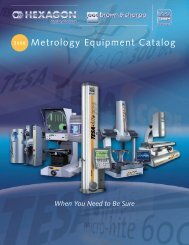shaping the future of metrology - Brown & Sharpe
shaping the future of metrology - Brown & Sharpe
shaping the future of metrology - Brown & Sharpe
Create successful ePaper yourself
Turn your PDF publications into a flip-book with our unique Google optimized e-Paper software.
Industry<br />
News<br />
<strong>Brown</strong> & <strong>Sharpe</strong> is having a direct input<br />
into a new standard for oil pipe<br />
TESA’s<br />
thread gaging.The new ISO standard for<br />
<strong>the</strong> manufacture and inspection <strong>of</strong> oil<br />
pipe threads is expected to be implemented<br />
before <strong>the</strong> end <strong>of</strong> <strong>the</strong> century.<br />
<strong>Brown</strong> & <strong>Sharpe</strong>’s role is in <strong>the</strong> consultative<br />
process prior to <strong>the</strong> first drafting <strong>of</strong> a<br />
new standard, 10422, which is expected<br />
in 1998.<br />
Alan Jones, <strong>Brown</strong> & <strong>Sharpe</strong> Custom<br />
Metrology Project Manager, is sitting on<br />
a British Standard subcommittee for <strong>the</strong><br />
creation <strong>of</strong> a new ISO specification to replace<br />
<strong>the</strong> present American Petroleum<br />
Institute (API) standard for oil pipe<br />
thread gaging. “Because <strong>of</strong> our expertise<br />
in measurement <strong>of</strong> oil pipe threads, and<br />
<strong>the</strong> facilities we have at Telford, England,<br />
some <strong>of</strong> <strong>the</strong> subcommittee meetings are<br />
being hosted by <strong>Brown</strong> & <strong>Sharpe</strong>,” Jones<br />
said.The subcommittee has been working<br />
on <strong>the</strong> new specification for five years,<br />
and meetings have been rotated between<br />
London, Aberdeen, and Telford.<br />
Custom Metrology has long been associated<br />
with oil pipe thread gaging applica-<br />
14 mfg. Shaping <strong>the</strong> Future <strong>of</strong> Metrology<br />
<strong>Brown</strong> & <strong>Sharpe</strong><br />
Assists In Drafting New<br />
Gaging Standard For Oil<br />
Pipe Threads<br />
tions and has developed <strong>the</strong> QUADCAM,<br />
an advanced thread gaging system.This<br />
gaging system is already being used by<br />
some oil pipe threaders who need <strong>the</strong><br />
QUADCAM system to verify <strong>the</strong> manufacturing<br />
quality which allows improved<br />
“down-hole” performance over that<br />
achieved by standard API connectors. Current<br />
API connector performance is partly<br />
limited by that design’s older methods <strong>of</strong><br />
hard gaging.<br />
The necessity for oil pipe thread gaging<br />
is critical. Once each section <strong>of</strong> an oil<br />
pipeline is set into its location, it is vital<br />
that <strong>the</strong> threads remain secure in order to<br />
avoid leaks and blowouts which would<br />
compromise <strong>the</strong> integrity <strong>of</strong> <strong>the</strong> entire<br />
pipeline, resulting in damage to <strong>the</strong> environment<br />
and costly repairs.The manufacture<br />
<strong>of</strong> oil pipes has been automated for<br />
QUADCAM fourcamera<br />
thread measuring<br />
machine (lower left) can<br />
correctly measure any API<br />
thread presented to it,<br />
regardless <strong>of</strong> <strong>the</strong> pipe<br />
position. The fully automatic<br />
system can handle<br />
nominal pipe sizes from<br />
60 mm to 250 mm.<br />
some years, yet inspection<br />
was manual and labor-intensive<br />
until Custom Metrology<br />
began to optimize <strong>the</strong><br />
inspection process.<br />
The QUADCAM was<br />
developed via a special<br />
project for Kawasaki Steel<br />
Corporation in Japan.The<br />
system works directly in <strong>the</strong><br />
production line at Kawasaki’s Chita<br />
Works 24 hours a day, performing 100<br />
percent inspection routines at high speed,<br />
and has made a major contribution to <strong>the</strong><br />
quality control system in <strong>the</strong> plant.<br />
The machine automatically aligns <strong>the</strong><br />
pipe, measures <strong>the</strong> threads via a scan<br />
process, calculates size and gives a component<br />
classification. All measurement results<br />
are analyzed through TML 2000<br />
s<strong>of</strong>tware, which gives fully comprehensive<br />
measurement displays and provides<br />
machine tool correction feedback. A typical<br />
cycle time for a thread is less than 12<br />
seconds. Calibration <strong>of</strong> <strong>the</strong> machine at<br />
regular intervals is also automatic and<br />
fully traceable. o<br />
Circle 705 on <strong>the</strong> READER SERVICE CARD



